La Garde-Guerin in Lozere |

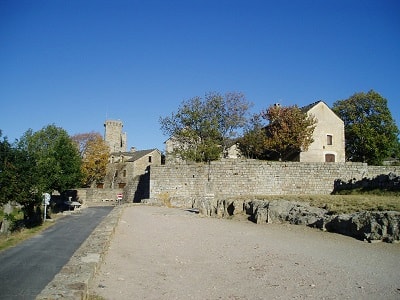 La Garde-Guerin is a fortified village located in the Lozere department in the Occitanie region. It is perched on a rocky plateau in a beautiful place and is one of many charming small villages to discover in the Cevennes National Park.
La Garde-Guerin is a fortified village located in the Lozere department in the Occitanie region. It is perched on a rocky plateau in a beautiful place and is one of many charming small villages to discover in the Cevennes National Park.
The village is traversed by the Chemin de Regordane (GR700), a nearly unique communication route connecting the Massif Central to the Mediterranean, very busy in the Middle Ages. Originally, this path was known as the Estrade (occitan estrada, "great road", from the Latin strata). In the 12th century, at the request of the Bishop of Mende, the village became a border post defended by a garrison responsible for the safety of travelers and goods on the Regordane. Throughout the 13th century, this place was simply called La Garde.
The name Guerin only appears in 1298. The fortified village, or castrum of La Garde, is jointly owned by a community of knight pariers (in occitan: "les egaux", from Latin pares), an economic and military community in the spirit of the flourishing chivalric schools in France from the 12th century who swore allegiance to the Bishop of Mende. Each parier owns a parerie, also called a part or portion, for which he assumes responsibility and collects the revenues: tolls, measurement rights (grain measurement), guidance and protection of travelers, animals, and goods on the portion of the Regordane they maintained, and dust rights (rights on the dust raised by herds).
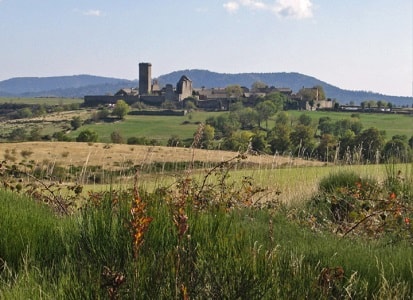 The population of the village has varied greatly over the centuries. There were more than 100 inhabitants in 1789, 158 in 1846, and 84 in 1936. Today, about a dozen inhabitants live there year-round. In summer, the population increases to about a hundred.
The population of the village has varied greatly over the centuries. There were more than 100 inhabitants in 1789, 158 in 1846, and 84 in 1936. Today, about a dozen inhabitants live there year-round. In summer, the population increases to about a hundred.
Regarding the natural environment of La Garde-Guerin, the village is located in the Cevennes National Park, a mountainous region in southern France. The region is known for its spectacular landscapes, rivers, and gorges, as well as its rich and varied flora and fauna. Common plant species in the region include the evergreen oak, the pubescent oak, the chestnut tree, the beech, the Scots pine, the juniper, thyme, lavender, heather, foxglove, martagon lily, Venus slipper, etc.
This fortified village, isolated in the middle of a plateau, dominates the jagged rocks of the Chassezac gorge. In the 12th century, the Bishop of Mende decided on its creation to protect travelers using the GR®700 Regordane Way, the only communication route between Auvergne and Roussillon. 27 nobles, the "pariers", settled there.
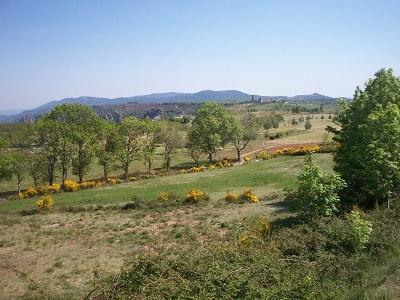 All their houses were perfectly identical. With its strong castle and most of its ramparts, the village, which is closed to automobile traffic, has preserved its appearance from that era practically intact. Today, most of the old parier houses serve as sheepfolds for the few inhabitants of the village. 1 km north, a path branching off from the old D906 leads in five minutes to the dizzying viewpoint of Chassezac, overlooking the chaotic gorges below where the torrent roars.
All their houses were perfectly identical. With its strong castle and most of its ramparts, the village, which is closed to automobile traffic, has preserved its appearance from that era practically intact. Today, most of the old parier houses serve as sheepfolds for the few inhabitants of the village. 1 km north, a path branching off from the old D906 leads in five minutes to the dizzying viewpoint of Chassezac, overlooking the chaotic gorges below where the torrent roars.
A very well-known stopover village on the GR®700 Regordane Way, La Garde-Guerin is now a particularly attractive tourist site. On-site, the tall watchtower, once surrounded by ramparts of which very beautiful remains can still be seen. The restored castle and village form a remarkably homogeneous medieval ensemble. It was once the domain of the "pariers knights," a very original military association, a sort of police militia that protected and guided travelers on the Regordane. There were up to thirty of them, subject to meticulous and precise statutes regulating charges and revenue distributions.
The donjon is 27 meters high. Its floors are vaulted in cradle style. Without stairs, they communicated by ladders and narrow trapdoors. The village church, formerly the chapel of the "castle," well restored, is considered a "jewel" of Romanesque architecture. From the top of the triumphal arch, a polychrome Saint Michael tramples a horned devil. Very beautiful capitals can be seen. Many ancient houses in the village have been restored. One can see superb doorways and antique staircases.
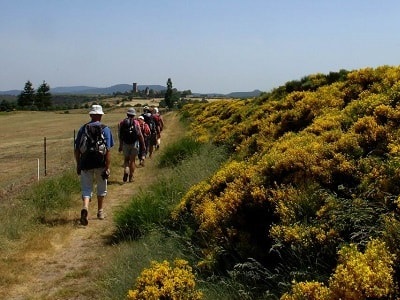 In 1965, La Garde-Guerin was an almost abandoned village, where a few farmers struggled to survive. Nevertheless, there was a very rich architectural heritage to preserve. It was possible to restore this unique village, to recreate a living economic and social environment. Thanks to the Directorate of Architecture in Paris, La Garde-Guerin was selected as a pilot village and received significant grants.
In 1965, La Garde-Guerin was an almost abandoned village, where a few farmers struggled to survive. Nevertheless, there was a very rich architectural heritage to preserve. It was possible to restore this unique village, to recreate a living economic and social environment. Thanks to the Directorate of Architecture in Paris, La Garde-Guerin was selected as a pilot village and received significant grants.
The creation of an inn in the most beautiful house in the village, the restoration of the church classified as a Historical Monument, the work to develop the streets and ramparts, as well as water supply works, were undertaken in 1966 and lasted a few years. 25 years later, what was a gamble became a reality: the inhabitants remained in the village, and others came to settle permanently or for the holidays, after the restoration of most of the previously abandoned houses.
Now, the concerted action of the inhabitants within an Association allows the continuity of the work undertaken. La Garde-Guerin has become a visited place by thousands of tourists. The respect for the environment and the enhancement of the architectural heritage of this site have restored its identity and life. A strong identity, a life rich in a whole past passed on to man to enlighten him, revealing to him another dimension, making him aware of the importance of his environment as a necessary component of his balance, of his way of life, as evidenced by the beauty of these places!
La Garde-Guerin is an old fortified village, remarkably situated on the edge of the GR®700 Regordane Way and above the Gorges du Chassezac, which it dominates by 400 meters.
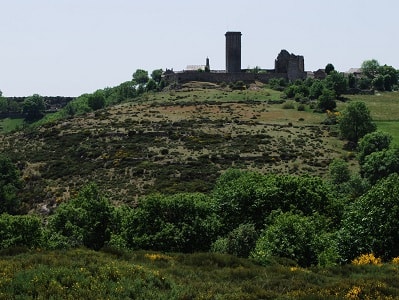 The traveler sees from afar the village, built at nearly 900 meters altitude, on a plateau of sandstone, often swept by winds. The base of the plateau is formed of granite rocks, through which the torrent of Chassezac has carved impressive gorges. The village benefits from an exceptional situation and overlooks the entire surrounding landscape. One only needs to visit the Pre de la Tour or the belvedere of the Gorges du Chassezac to be convinced. Today, one can still see everything around without obstruction. Furthermore, the site is crossed by the GR®700 Regordane Way which has always played an important role.
The traveler sees from afar the village, built at nearly 900 meters altitude, on a plateau of sandstone, often swept by winds. The base of the plateau is formed of granite rocks, through which the torrent of Chassezac has carved impressive gorges. The village benefits from an exceptional situation and overlooks the entire surrounding landscape. One only needs to visit the Pre de la Tour or the belvedere of the Gorges du Chassezac to be convinced. Today, one can still see everything around without obstruction. Furthermore, the site is crossed by the GR®700 Regordane Way which has always played an important role.
It is a natural communication route, traced from North to South, on the eastern face of the Cevennes. It connected Montpellier and Nîmes to Puy-en-Velay (departure of the St. James' Way GR®65, the GR®700 Regordane Way or Chemin de St Gilles, and the Stevenson Trail GR®70) and to Clermont Ferrand, going through Ales, Portes, Chamborigaud, Genolhac (tour of Mont-Lozere GR®68), crossing Villefort, continuing towards La Garde-Guerin, Prevencheres, Le Thort, La Bastide Puylaurent, Luc, Langogne.
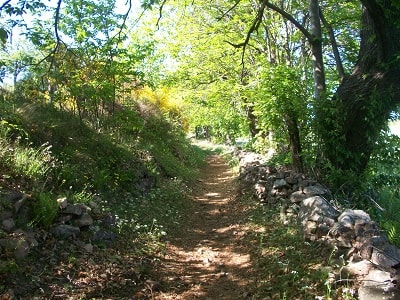 This site bears the remains of a solid human settlement since the Neolithic. How could the ancient path of the Regordane not be lined with more or less fortified stations? La Garde-Guerin was a dream place to establish a stronghold, that is to say, a fortified station with wooden palisades rather than stones.
This site bears the remains of a solid human settlement since the Neolithic. How could the ancient path of the Regordane not be lined with more or less fortified stations? La Garde-Guerin was a dream place to establish a stronghold, that is to say, a fortified station with wooden palisades rather than stones.
Later, the Gauls must have erected an oppidum or stronghold. Unfortunately, we know nothing about this period. What we can say is that this Regordane path was a pre-Roman transhumance route.
Before Caesar's conquest of Gaul in 52 BC, the Celtic tribe of Gabales occupied the territory of present-day Lozere. They participated in the struggle for the independence of Gaul alongside Vercingetorix and the tribe of the Arvernes of which they were "clients": they owed them respect and devotion, certain services, and military assistance.
A cheese appreciated by the Romans
The Gabales lived from agriculture and livestock and used the GR®700 Regordane Way as a transhumance route and as a trade route for wine and other products from the Cevennes which were already sold in Nîmes, cheeses for example.
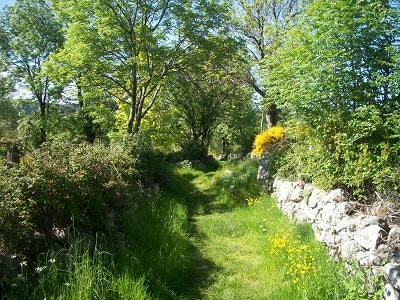 Pliny the Elder, who died in the 1st century AD during the eruption of Vesuvius, said that the cheese most appreciated in Rome was that from Mont Lozere and the Cevennes. The Gallo-Romans continued to use this road. It is known that far from adhering to the principle of a straight line, Roman roads often follow the sinuosities of earlier Gallic routes. They traveled with carts, and a relay system along the road allowed them to bring products from the Mediterranean to Lozere. Oyster shells have indeed been found during excavations on various archaeological sites. In some places, like the Estrade of Saint-Andre de Cap-Ceze, the ruts made by the wheels of the carts can be distinctly seen. These ruts are spaced 1.42 m apart, just like in Pompeii. In Coudoulous, on a branch of the Regordane that went west towards Mende, one can even see the traces of "shoes" in the rock that allowed cart drivers, struggling uphill, to hold the cart in place.
Pliny the Elder, who died in the 1st century AD during the eruption of Vesuvius, said that the cheese most appreciated in Rome was that from Mont Lozere and the Cevennes. The Gallo-Romans continued to use this road. It is known that far from adhering to the principle of a straight line, Roman roads often follow the sinuosities of earlier Gallic routes. They traveled with carts, and a relay system along the road allowed them to bring products from the Mediterranean to Lozere. Oyster shells have indeed been found during excavations on various archaeological sites. In some places, like the Estrade of Saint-Andre de Cap-Ceze, the ruts made by the wheels of the carts can be distinctly seen. These ruts are spaced 1.42 m apart, just like in Pompeii. In Coudoulous, on a branch of the Regordane that went west towards Mende, one can even see the traces of "shoes" in the rock that allowed cart drivers, struggling uphill, to hold the cart in place.
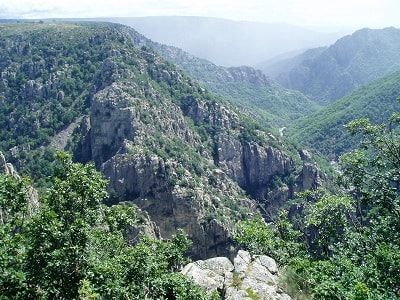 A privileged site
A privileged site
Local powers organized themselves around certain privileged sites, one of which was La Garde-Guerin, thanks to its position on a frequently used communication axis. This did not escape the lords who set up people there in the 11th century, perhaps even earlier, to guard the road and ensure the protection of travelers and goods. They probably built very quickly, perhaps in the 11th century, a castle with a watchtower. The current village owes the first part of its name to the existence of this structure from which one could watch the entire horizon.
In the "Etymological Dictionary of Place Names in France", we can read that the word "Garde" comes from the Germanic "Wart" and means guard, watchtower, fortress. Many villages or towns in France are also called La Garde: La Garde Freinet, La Garde Adhemar, and it has been observed that they were all built on heights, in strategic locations. In La Garde Freinet for example, a Saracen fortress was built in the 9th century. It seems that for a long time people spoke of the stronghold of La Garde. In a text written in the 12th century, in late Latin, one can read: "castrum quod vocatur la Garda", the stronghold that is called La Garde. It is not known exactly when the name La Garde was supplemented by Guerin. It is generally thought that the lords who settled at La Garde around the 12th century were Guerin. "Guerin" is a common surname in the three baronies of Randon, Apcher, and Tournel. The existence of the Guerins is attested in a deed of donation to the abbey of Gellone now Saint-Guilhem du Desert dated 1054.
It is a Guerin from Tournel who took charge of this castle, who became its suzerain. The Tournel was indeed solidly implanted in Villefort and possessed La Garde. The Lords of Tournel were masters of Mont Lozere and part of the Sauveterre. They garrisoned some key points and soon paid all their attention to this unique penetration route connecting the South to the Massif Central. One did not pass along the banks of the Rhône, a border that has always been heavily guarded. When the name La Garde was supplemented with Guerin, was it not to pay homage to these powerful Guerin lords of Tournel? Association G.A.R.D.E, La Garde-Guerin, 48800 Villefort
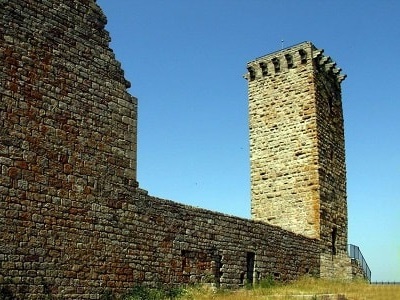 The Secret of the Donjon of La Garde-Guerin
The Secret of the Donjon of La Garde-Guerin
Once upon a time, in the heart of the 12th century, there was a small village perched on a rocky plateau, surrounded by thick forests and deep gorges. This village was La Garde-Guerin. Its stone houses lined the winding streets, and at the top of the hill stood an imposing donjon. The donjon, 27 meters high, was the symbol of the power of the Pariers knights, those nobles who had sworn to protect the travelers using the Regordane Way. But behind its thick walls lay a mystery, a secret jealously guarded by the elders of the village.
One winter evening, while snow covered the roofs, a young shepherd named Gaspard discovered a trapdoor hidden beneath an old tree stump. Intrigued, he descended into the depths of the donjon, by the light of a flickering torch.
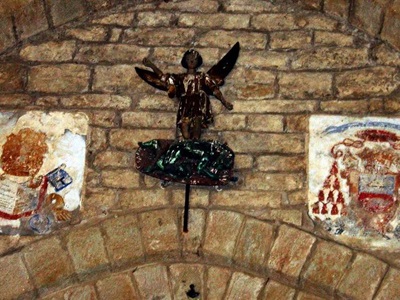 There, in a vaulted room, he found a carved wooden chest. Inside lay a yellowed parchment. Gaspard deciphered the ancient characters and discovered the history of the village. He learned that the parie knights were not only guardians of the road, but also guardians of a legendary treasure. This treasure, hidden somewhere in the undergrounds of the donjon, was made up of precious objects, jewels, and above all, a mysterious elixir capable of curing all diseases.
There, in a vaulted room, he found a carved wooden chest. Inside lay a yellowed parchment. Gaspard deciphered the ancient characters and discovered the history of the village. He learned that the parie knights were not only guardians of the road, but also guardians of a legendary treasure. This treasure, hidden somewhere in the undergrounds of the donjon, was made up of precious objects, jewels, and above all, a mysterious elixir capable of curing all diseases.
Gaspard decided to share his discovery with the other villagers. Together, they explored the secret passages of the donjon, braving the traps and riddles left by the ancient knights. They found secret rooms filled with riches, but the elixir remained unfound.
Over the years, the village prospered thanks to this hidden treasure. The inhabitants lived in harmony, healed of their ailments, and the legend of La Garde-Guerin spread throughout the region. But one day, a stranger arrived in the village. He called himself Lorenzo, and his eyes shone with a greedy light. He had heard about the treasure and was ready to do anything to seize it. Lorenzo entered the donjon, solving the riddles with diabolical skill. He finally reached the room where the elixir lay. But the moment he touched it, a mysterious force threw him back, leaving him fainted on the stone floor.When he regained consciousness, Lorenzo was changed. His greed had disappeared, replaced by genuine compassion for the villagers. He decided to protect the treasure instead of stealing it.Since that day, La Garde-Guerin has become a healing place for all those who seek the legendary elixir. And the secret of the donjon remains well guarded, passed down from generation to generation.
 La Garde-Guerin
La Garde-Guerin
Former holiday hotel with a garden along the Allier, L'Etoile Guest House is located in La Bastide-Puylaurent between Lozere, Ardeche, and the Cevennes in the mountains of Southern France. At the crossroads of GR®7, GR®70 Stevenson Path, GR®72, GR®700 Regordane Way, GR®470 Allier River springs and gorges, GRP® Cevenol, Ardechoise Mountains, Margeride. Numerous loop trails for hiking and one-day biking excursions. Ideal for a relaxing and hiking getaway.
Copyright©etoile.fr